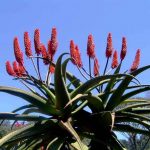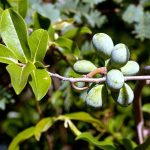TREE LIFE
June 1985
MASHONALAND CALENDAR
Saturday June 1st: Botanic Garden Walk at 1100 hours, possibly to look at the damnable Grewia.
Sunday June 16th: Cupar Farm, Beatrice, the home of Dudley Steele. We are off to do a recce this weekend but we have always been well rewarded by our trips to Beatrice, so we are confident of an exciting day. The bus quote proved exorbitant so we will be travelling in cars again, a security guard will look after the cars which remain at the car park. Meet at Monomatapa Car Park at 0845 to arrange transport and leave promptly at 0900 hours.
Friday – Monday, August 9th – 12th Gonarezhoa: Please note this trip is now well oversubscribed at a number which is bordering on the unmanageable. All the Camp Sites at Chipinda Pools have been booked and are held by us. IT IS THEREFORE NOT POSSIBLE FOR ANYONE SIMPLY TO ARRIVE; THEY CANNOT BE ACCOMMODATED AS PARKS WILL NOT ALLOW MORE PEOPLE PER CAMP SITE. This is unfortunate, but necessary. The only names recognized are those on Phil’s official list. There is a supplementary list in case of cancellations but as the official list is already too long, we cannot promise anything. All names on the official list will receive a supplement with this newsletter.
MATABELELAND CALENDAR
Sunday June 2nd: Hillside Dams. Meet at 0830 hours at the end of Moffat Avenue, near the Dams, as you come from the Esigodini Road.
BOTANIC GARDEN WALK, MAY 1985
Unfortunately Tom Muller was unable to join us for the walk but briefed me beforehand, so we were able to begin looking at a closely knit plant order, the Malvales, which contains four indigenous families, the TILIACEAE, STERCULIACEAE, BOMBACACEAE and MALVACEAE. It is appropriate that we should look at the Malvales after having examined the Urticales, ULMACEAE, URTICACEAE, CECROPIACEAE and MORACEAE, in March and April. I stated in March that the Urticales belonged with the other catkin families like the oak and beech, we even saw the long catkins on Boehmeria. Well that is one view and is followed by Cronquist. On the other hand Berg, whose classification of the figs was presented last month, believes that the Urticales are more naturally placed alongside the Malvales. On venation alone the Celtis leaf, ULMACEAE, does bear a remarkable similarity to that of Grewia, TILIACEAE, and the three or more veins which we repeatedly saw radiating out in the Urticales are also common in the Malvales The TILIACEAE contain over 20 confusing Grewia species most of which Tom has represented in the Botanic Garden, so I will allow Tom to guide us through this taxing family, possibly next month. We began with the STERCULIACEAE. The members of the Malvales are characterized by a covering of star like hairs and a mucilage secretion produced in canals in the wood. The leaves are alternate and often as in the case of the first tree, Sterculia appendiculata, have palmate venation. The different families are separated on their floral structure. S. appendiculata is a stately tree sparingly found in the lower Mazowe Valley and Mudzi area. Tom’s trees do not appear to show any sign of a peeling bark. We wandered into the rocks opposite the pond to find S. quinqueloba which may be remembered by the peculiar stink all over. This reminds us that the genus honours Sterculius the Roman God of privies and manuring. This is the species with a large leaf and small fruit in contrast to S. africana which we saw next with its small leaf and large fruit. These species often grow alongside each other in granite kopjes. In Sterculia the ovary is made up of a number of chambers which are not fused together, instead they separate as they expand and finally split open. The pods of S. africana reveal the tick like seeds embedded in a mat of hairs which itch like crazy. Later on in the S.E. Lowveld section we saw S. rogersii, a squat, swollen trunked tree with smaller leaves. It grows in rocky outcrops and dry woodland in the south of Zimbabwe.
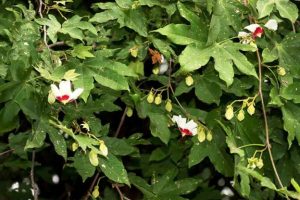
Triplochiton zambesiacus. Photo: Bart Wursten. Source: Flora of Zimbabwe
Near the S. africana we found Triplochiton zambesiacus also of the STERCULIACEAE and also with typical venation. This stately tree has apparently been referred to as the Zambezi Oak, and is endemic to the Zambezi Valley where it grows alongside the river on alluvium and termite mounds from above Victoria Falls to A camp below Kariba Gorge. It has a characteristically smooth flaking bark.
Across the lawns we found the distinctive leaf of Cola greenwayi. These leaves are simple and, unlike the other STERCULIACEAE, have pinnate venation. At the top of the petiole is a pulvinus or swollen joint. From this joint the leaf sticks upwards at an angle to the petiole. These strange leaves are commonly seen in the Vumba and other evergreen eastern forests where Cola is a second storey tree. Species of Cola in West Africa produce kola nuts with a high caffeine content which enables chewers to sustain fatigue.
Below the Ficus bubu lawn we found Dombeya kirkii, this is a white flowering species from the riverine thickets of the lowveld and has a leaf with a pointed tip, in contrast to the common white Dombeya, D. rotundifolius, of the Highveld which we saw later in the woodland section. The leaves of this species are round as the name implies. Just to jump briefly to the end of the walk, we finished off with D. burgessiae, the pink flowering species of high altitude forest edges where it forms a tall shrub. To confuse us this specimen had a number of white blossoms as well.
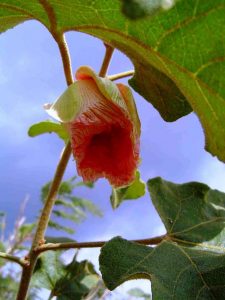
Azanza garckeana. Photo: Bart Wursten. Source: Flora of Zimbabwe
We can but admire Tom’s baobab, Adansonia digitata, with their fast swelling trunks. These belong to the BOMBACACEAE which is related to both the STERCULIACEAE and MALVACEAE. The radiating veins here lead to separate leaflets of the digitate leaf. The BOMBACACEAE often have large flowers with free petals, i.e. not fused to one another. This allows the nectar, which is sometimes produced by the sepals, to run into the flower cup. Later in the walk we smelt the musty odour of the exotic Bombax blooms near the herbarium. This smell as well as the flower shape implies pollination by bats. Although lesser bush babies are also reported to pollinate the baobab. I once offended my Shona host by carelessly destroying a baobab flower near his home in Mutoko. The spirits of the flower serve a useful function in protecting the fruit which will later provide a refreshing snack. The high proportion of water storage tissue in the trunk results in very loosely packed wood. It is perhaps noteworthy that balsa wood is obtained from a South American BOMBACACEAE, Ochroma pyramidale. The MALVACEAE is the Hibiscus family. We examined leaves of the Azanza garckeana which had been collected from alongside the St. George’s College fence on the far side of the Acacia section. It also grows naturally on the kopje alongside the water tanks. The similarity to the other families was immediately obvious although the ‘burst pipe’ on the under surface of the main vein is quite distinctive. But just to see the MALVACEAE flower we wandered into the high altitude forest section to find the delicate pink blossoms of Pavonia columella. This plant scrambles on the edge of the Vumba forest where the attractive flowers more than compensate for the unpleasant odour of the leaves. The most economically important MALVACEAE cultivated in Zimbabwe is a species of Gossypium, the cotton plant. Some of the caterpillars, bollworm, which infest the cotton ball are restricted to the order Malvales. Therefore populations of these pests may continue to live in the surrounding baobabs, Sterculia and Azanza, from where they will re-infest the crop. These caterpillars are not the most significant pests of cotton so cutting out all Malvales will, fortunately, not be a successful control method. To step on step further back we may see where the Malvales fit in the broader context. According to Cronquist they belong in the large subclass the Dilleniidae The central order within the Dilleniidae is the Theales which we have already considered, OCHNACEAE, DIPTEROCARPACEAE and CLUSIACEAE. A number of orders radiate from the Theales, one of which is the Malvales, another is the Violales, containing FLACOURTIACEAE. Just visualize the flowers of Ochna, the baobab and Dovyalis, they all have 5 free petals and a host of stamens in the radially symmetrical flower.
Next month hopefully we may consider the TILIACEAE, but as Grewia is a headache genus, I hope to prepare a rough table to help the identification.
-Kim ST.J. Damstra.
OUTING TO ‘KUJAWY’, C.C. CLOETE’S FARM, GADZEMA WITH CHEGUTU MEMBERS ON 19TH MAY 1985
Take 50 people to the same place on the same day and you end up with as many versions of what we saw and did. The Chegutu trip was no exception. Pride of place, as Meg stated, must go to the Ficus nigropunctata emerging from an Acacia goetzei. This is a real non fig, if that makes sense. The leaves are furry and have a finely serrated margin which just seems out of place within the genus. The tree did have a milky juice, annular scars where the stipules had fallen, and three veins from the base. Although this specimen had a sturdy trunk, the roots had as yet not reached the ground 1.5 m below its perch. Had it been a F. thonningii we would have expected a much longer root at half the tree size. Once again we noted that the trunk was not black, nigro, although it did have lenticels, the punctata. Current fig theory believes that even these rarer species are pollinated by their own species of wasp, this does seem remarkable although it would be interesting to know how common they are in local patches. Gill Masterson showed us a specimen she found on the Young’s farm on the Chikari Road on one of our trips. But much as we may admire this rare tree, many of us will never come across it again, so it may thus be far more rewarding to avert the eye to the smooth barked mountain acacias, Brachystegia glaucescens, trees that conjure up memories of early childhood for Molly, she breaks into one of her delightfully husky laughs, eyes gleaming through exhaled smoke. B. glaucescens is an emotive tree, whose feel defies description. And here they were, all over the kopje, their limbs bulging with those characteristic swellings. Amongst these giants were Croton gratissimus and Mundulea sericea so much taller than we usually see them. Maureen was so impressed with the silver Croton leaf that she had forgotten to smell them.
For those who are superstitious many things come in threes; Margaret noted the leaves of Gardenia ternifolia in whorls of three and the three veins from the base of Strychnos leaves, both S. innocua and S. potatorum were plentiful. And while Marjorie completes the triad by scrabbling in her bag for the three soft leaflets of Rhoicissus revoilii, one of the other members recalls her find of the day; being the wife of an eminent local zoologist she had collected a truncheon of Euphorbia matabelensis which she hope to grow for bird lime. Could this be an attempt to catch oxpeckers on buffalo?
Joy thinks she will remember to look for the ‘ball and claw’ on Zanha africana and Hazel could recall that there were two species of Ximenia one with a single fruit, X. caffra, and the other with fruit in pairs, X. americana. Someone ahead of us succeeded in eating the ripe Friesodielsia obovata fruit along the path to lunch.
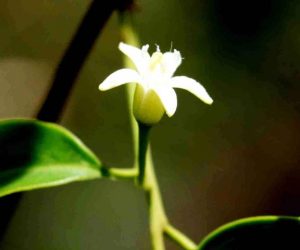
Olax dissitiflora. Photo: Bart Wursten. Source: Flora of Zimbabwe
While struggling over the identification of one plant, the brain was suddenly overwhelmed with images of wedding receptions and almond icing, Agatha Christie and the cyanide tablet! Olax dissitiflora. Apparently the cyanide does not exist inside the leaves, it is only when the leaf is crushed and the cells are broken that a chemical reaction is set in motion releasing the cyanide into the air, an effective deterrent to many herbivores. Soon we were surrounded by a clan of glue sniffers; the excitement of plucking and crushing, furrowed brows and hands next to the nostrils in a plateau of anticipation for the climax, whereupon the smile broadens to a knowing grin.
Brian who keeps his ear to the herbarium news lines, did not even wait for the afternoon’s riverine walk to inform us all that our friend Salix subserrata is no more! Yet another sinking of species has led it to a name change as it is combined with S. mucronata of the Cape Province. Further along the river Owen discovered a nursery of seedling in the mud beneath a Syzygium guineense. A number of these trees were hastily adopted by surrogate parents. We wandered past Mimusops zeyheri, Nuxia oppositifolia, Combretum erythrophyllum, Ziziphus mucronata and Faurea saligna amongst others, before turning up the recently eroded spillway and back to the dam itself. Having boarded the bus we drove down the gravel road flanked by tall Acacia gerrardii and Combretum hereroense with its furry mouse-ear leaves. Yes, we do go out to find trees, but the trees, the trips and the people all get fused into one occasion. We must thank the Chegutu folk for their help in the organization and for meeting up with us as well.
-Kim ST.J. Damstra
MATABELELAND NOTES
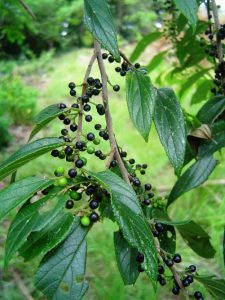
Trema orientalis. Photo: Bart Wurten. Source: Flora of Zimbabwe
Firstly, if anyone, coming from elsewhere, wishes to contact a Matabeleland member, it is suggested that they try Mrs. Ruth Archer, phone 61587, or, of course, myself, not always easy, 31039. For our May meeting, on the 5th, we went to the Matopos, and with wonderful weather and expert guidance from the Archers, we had one of the best days there that I can remember. We started near the Lower Outspan, in the morning, then lunched near Efifi, and between the 2 area, identified over 90 different species, including : No Acacias! Acokanthera schimperi, Albizia antunesiana and A. tanganyicensis, Allophylus africanus with its under surface hairs, Apodytes dimidiata, Artabotrys brachypetalus, the first of which showed no curling peduncle, and so foxed us awhile, Azanza garckeana, with gland or scar on the under mid rib, Afzelia quanzensis, Brachylaena rotundata, Canthium lactescens, Canthium lividium, Cassia abbreviata, Celtis africana and Trema orientalis, Clerodendron glabrum and C. myricoides, Combretum apiculatum, mostly with good autumn tints, Commiphora marlothii, Cordia grandicalyx, Croton gratissimus, Cussonia natalensis in the distance only, Dombeya rotundifolia, Elephantorrhiza goetzei, Erythrina latissima, Euclea divinorum, E. natalensis, E. racemosa, Erythrococca menyhartii, Euphorbia cooperi, E. griseola, E. ingens, Faurea saligna, Ficus glumosa, F. ingens, F. sur, F. thonningii, Gardenia volkensii, Heteropyxis dehniae, Kirkia acuminata, all very small, Maytenus senagalinsis and M. heterophylla with leaves much smaller than in Bulawayo district, Mimusops zeyheri, Ochna glauca, Olea europea subsp. africana, Pappia capensis, Parinari curatellifolia, Pavetta eylesii with its flaky bark, P. schumanniana, Pittosporum viridiflorum, Pouzolzia mixta, Pterocarpus angolensis and P. rotundifolius, Pterolobium stellatum, Rhus leptodictya, Rhus pyroides, Schrebera alata, Sclerocarya birrea, Securidaca longepedunculata, Securinega virosa, Sericanthe andongensis, Sesbania sesban, Strychnos cocculoides, S. madagascariensis, S. matopensis, S. spinosa, Tarenna neurophylla, T. zimbabwensis, Teclea rogersii, Turrea nilotica, Turrea obtusifolia, Vangueria infausta, having sparse, very rounded leaves, and widely separate decussate branches, so that I, personally argued, wrongly, I am now convinced, that it could be Canthium, certainly not Vangueria! However, later comparison with the Vangueria of Bulawayo district, which certainly differ a bit, suggested that the conspicuous net veining below, and the typical soft hairy leaves confirmed it as Vangueria infausta; we also Vernonia subuligera, formerly V. stipulacea, and the other perhaps V. amygadalina, though the teeth on the leaf margins were larger than one might expect, though the flower is white. Near Efifi we saw a most vigorous and good sized Zanthoxylum capensis, with extremely prominent thorny bosses.
-C. Sykes,
ROOT NOTE: In line with last month’s botanic garden walk, a few lines from D.H. Lawrence’s poem “Figs”, heavily edited I am afraid, the whole is a literary treasure but possibly inappropriate here :
“The fig is a very secretive fruit
Involved,
Inturned,
The flowering all inward and womb-filled;
And but one orifice
There was a flower that flowered inward, womb ward,
Now there is a fruit like a ripe womb
There never was any standing aloft and unfolded on a bough.
Like other flowers, in a revelation of petals;
Silver pink peach, venetian green glass of medlars and sorb apples,
Shallow wine cups on short, bulging stems
Openly pledging heaven:
Here’s to the thorn in flower! Here is to Utterance!
The brave, adventurous rosaceae.
Folded upon itself, and secret unutterable,
The milky sapped, sap that curdles milk and make ricotta,
Sap that smells strange on your fingers, that even goats won’t taste it;
Folded upon itself, enclosed like any Mohammedan woman,
Its nakedness all within walls, its flowering forever unseen,
On small way of access only and this close curtained from the light”
THE GONAREZHO TRIP : 9 – 12TH AUGUST 1985
The trip is crystallizing rapidly and Phil, Meg and I have had a chat to Cathy Sharp who is also on the LNHS committee. The following details are available.
Bus to leave Harare at noon on Friday 9th and return Monday evening sometime. No-one has yet been able to confirm whether Tuesday is also a public holiday – an extra day would be appreciated. The provisional program looks most rewarding.
You must take anti malaria tablets. This is not an idle threat, a number of tourists to Gonorezhou died of malaria last year and we are not prepared to risk this; Remember there is chloroquine resistant malaria in Zimbabwe so these tablets may be useless. Please use Deltaprim, and read the instructions carefully. If you have never used Deltaprim before please try a tablet immediately, if you react adversely consult your doctor now for a possible alternative. Remember a few hours of nausea is better than a tombstone. No tablets, no trip, I regret this is not an idle threat.
Anyone with access to a large tent, for 4 to 6 people, please contact Phil or myself immediately. We need to send these ahead so they can be erected before we arrive.
We will be camping, everyone will be accommodated under canvas but we cannot promise privacy. There are showers with hot water, flush loos and chlorinated drinking water on tap.
Everyone needs to bring their own sleeping bag, toiletries, mosquito net, advisable, and alcohol other than beers. It can be cold at night, and hot during the day. We do not expect rain.
LNHS will be organizing the catering. Cokes and beers will also be on sale if required. A torch is recommended.
Will all people who do not have access to a stretcher or camping mattress, as well as anyone who can offer these facilities, please contact us as soon as possible.
There is little danger of wild animals at camp site although we will be accompanied by an armed game scout on all of our walks. This does mean that everyone will be expected to stick together, we cannot have stragglers.
Salt tablets may be needed, it can get hot during the day and we do hope to be many miles away from the camp on rotten roads during the heat of the day.
If your health is shaky, please reconsider your decision to come very carefully, this trip is a unique opportunity for the whole party. We will try to care for everyone but this is a camping trip and not a luxury tour. I do not promise a red carpet, although the LHNS are doing a lot for us. I do not mean to sound negative, I just want to lower your expectations. I am grateful for all our hosts are trying to do, remember we are all arranging the trip in good faith. Any help or suggestions will be most appreciated. Any doubts or comments can be put to Phil, Meg or myself and we will sincerely try to find the answers.
Contact numbers Kim Damstra and Phil Haxen 8871413
Meg Coates Palgrave 84419
Joy Killian, Treasurer 308398
KIM DAMSTRA ACTING CHAIRMAN


